Live Long and Die Out
by Joe Veix
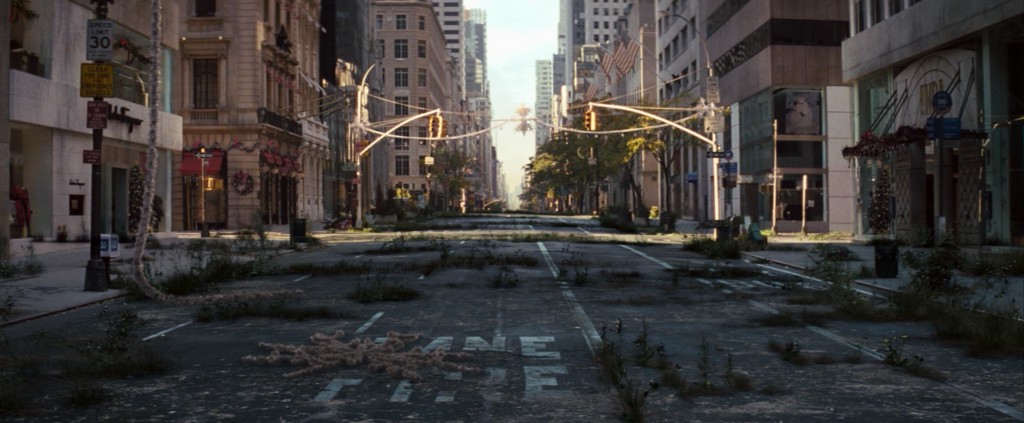
If you’re prone to flights of depressive thoughts in the shower (who isn’t?), you’ve perhaps briefly entertained the notion that, since humans are responsible for every environmental catastrophe, maybe the planet would be better off if we all just died. While you might rid yourself of such a bleak thought by making the water scalding and moving on to thinking about something cruel you did in middle school, there is a group of extremist hippies called the Voluntary Human Extinction Movement (VHEMT, pronounced “vehement”) that actively promotes the idea. Their philosophy is simple: Humans should stop breeding, and allow ourselves to go extinct. As their motto puts it, “Live long and die out.”
The movement was founded in 1991 by Les U. Knight, a substitute middle school teacher in Portland, OR. After working with the environmental group Zero Population Growth in the early seventies, he became disenchanted with their “stop at two” slogan, which he felt wasn’t drastic enough. He imagined a more effective alternative: stop at zero. The VHEMT, according to Knight, is not a “code of behavior to live by” and “it can’t get into arguments, tell people what to do and think, nor get punched for doing so.” It’s only concern is ceasing all human reproduction, to allow the environment to recover.
Knight claims that the idea has always existed in the private thoughts of a few enlightened people throughout history, and that he has merely provided a name and context for it. This is dubious, though many writers and organizations have raged against the environmental dangers of overpopulation: Thomas Malthus’s infamous An Essay on the Principles of Population was published in 1798; numerous population-focused groups formed in the sixties and seventies, including the shady1 Population-Environment Balance and Zero Population Growth; there’s a subreddit for overpopulation (of course there is) founded in 2009 with over ten thousand readers; and the Church of Euthanasia, run by Rev. Chris Korda2, who — following the instructions of an “alien intelligence known as The Being” — advocates for the suicide and cannibalism of everyone on earth. The VHEMT is the only serious organization committed to peacefully annihilating all of humanity.
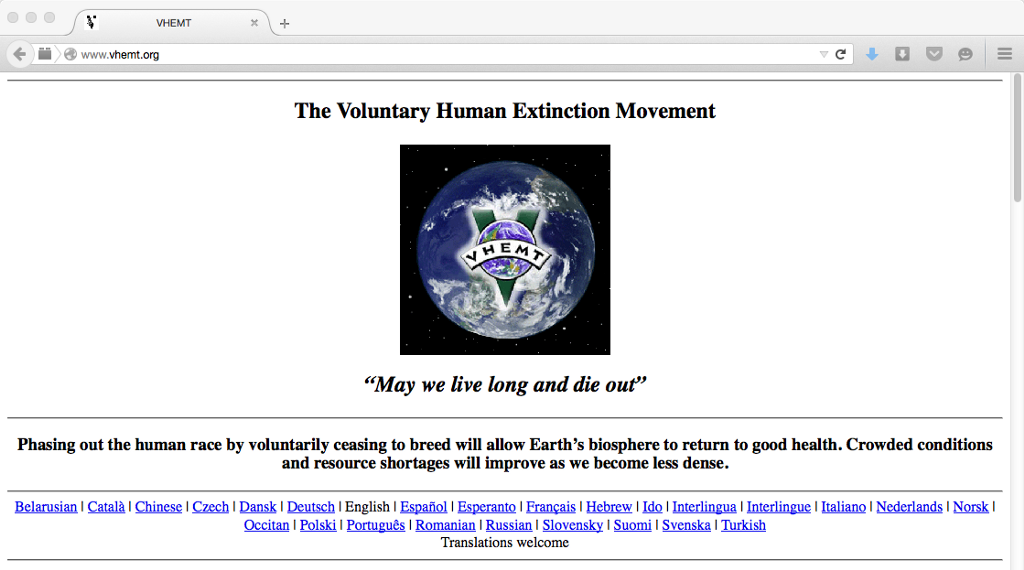
For those with reservations about supporting the extinction of humanity, most concerns are addressed on the VHEMT’s incredibly helpful website. Built in 1996 with little design changes since, it’s structured like a long FAQ. It’s also available in twenty-five languages, so good news if you speak Occitan.
Here are a few: Don’t you like babies? (Yes.) Are we all supposed to kill ourselves? (No.) Is this another one of those suicide cults? (No.) Didn’t Hitler have the same ideas? (No.) If there were a magic button for extinction, would you press it? (No.) Why don’t you just kill yourself? (Whoa.)
That last one is the most Frequently Asked Q.

Knight decided his best option for spreading his gospel pre-internet was by printing a zine. So in 1991, with little publishing experience, he started These Exit Times. He collected a few essays and comics (all written/drawn by him) and published them at a local print shop (I like to imagine an elderly store owner reading a few sentences with one eyebrow raised, and becoming extremely confused and upset). The zine reached roughly six hundred “volunteers” — most of whom discovered it after pieces in the New Age Journal and the zine guide Factsheet Five — by the time he printed its third and final issue in 1994. After that, he moved his operation online to save on printing and postage. Scans of each issue still exist online here, here, and here.
Though the zine’s title references the suicide manual Final Exit (published the same year) and is preoccupied with its goal of final mass death, its tone is surprisingly jocular. This is most evident in its charts and diagrams, most of them drawn by Knight himself. Take this timeline, for example, where “hooray!” signifies the death of all homo sapiens:
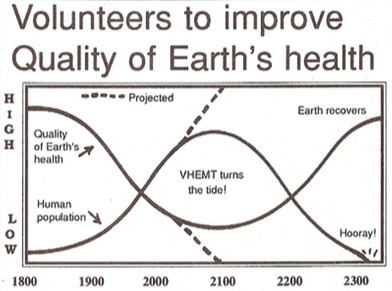
This is the “Path of Progressive Awareness” (which is not a little phallic?).

And this “eco depth guage” [sic] wouldn’t necessarily look out of place in Seventeen or BuzzFeed:

The issue includes a column from Les (called “Les Talk”), arguing for all men to get vasectomies. It closes with a polite letter to “non-members” of the movement. “No matter what you’re doing to improve life on planet Earth,” it reads, “I think you’ll find that phasing out the human race will increase your chances for success.” Overall, the first issue set the tone for the entire movement: A weirdly polite and upbeat expression of an oppressively dark worldview.
Issue Number Two (released in 1992) is largely a response to the first. It’s packed with reader mail, all of it supportive. One letter comes from someone named Tree Dream in Santa Cruz, CA: “Just so happens I’m with you, I-Bro.”
Deborah from Summertown, TN adds:
I was absolutely flabbergasted to be made aware of the VHEMT. I have long regarded humans as a parasitic infection on the planet […] and have only realized in the last decade that this world is utterly ravaged by hordes of greedy, inconsiderate, thoughtless two-legged beasts.
And Darryl from Richmond, VA comments:
I had a vision of mankind as a candle flame and the candle voluntarily slowly extinguishing it and going out. I think this ‘sacrifice’ could be considered the greatest moral act that people could accomplish, akin to the crucifixion in intensity, if not as dramatic.
Issue Two also attempts to get practical about accomplishing human extinction; there’s a long section listing other like-minded groups focused on reducing the population, though two of them are covert nativist organizations. The art also gets more bizarre. There’s a comic from the writer Kelpie Wilson, called “Bonobo Baby,” in which a woman cheerily gives birth to an ape.
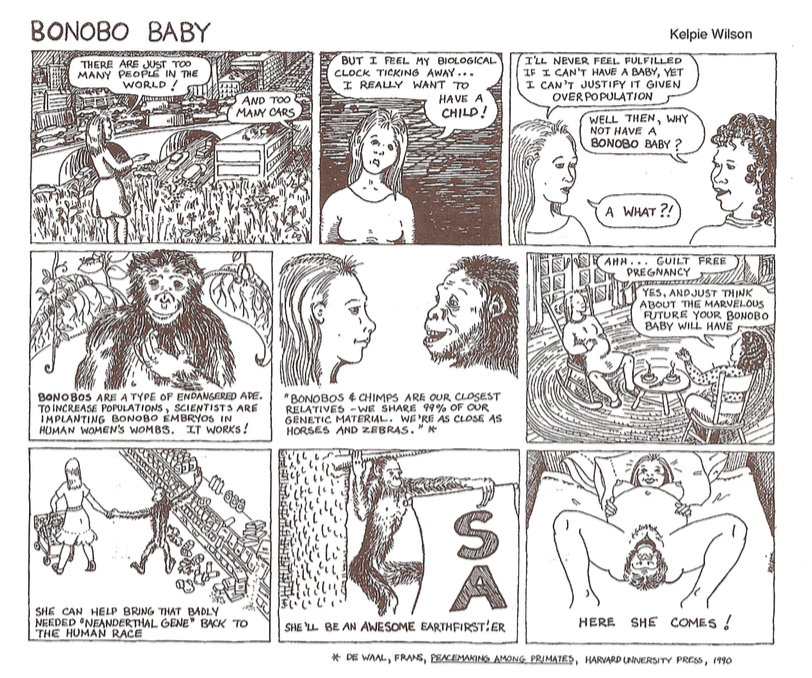
This convinces her friends to not have children (????).

There’s an interview with the Gaia Liberation Front’s “spokesorganism” Geophilus, who serves to make the VHEMT actually seem reasonable by comparison. Geophilus supports involuntary sterilization, though he “would also welcome the escape of any new anti-human viruses — such as the airborne version of AIDS that might result from AIDS research on mice.”
And “Les Talk” returns with an article about abortion.
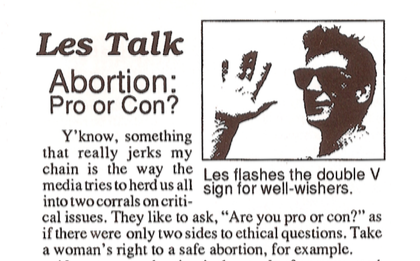
For the third issue, the structure of the full-color issue remained the same as before, including the usual essays, letters, and comics, but the production value went way up, thanks in part to cartoonist and animator Nina Paley. “[Her] art and comics made a huge improvement in the newsletters’ appearance,” Knight said. She provided illustrations and a comic to the issue (and later, created a few animated shorts).
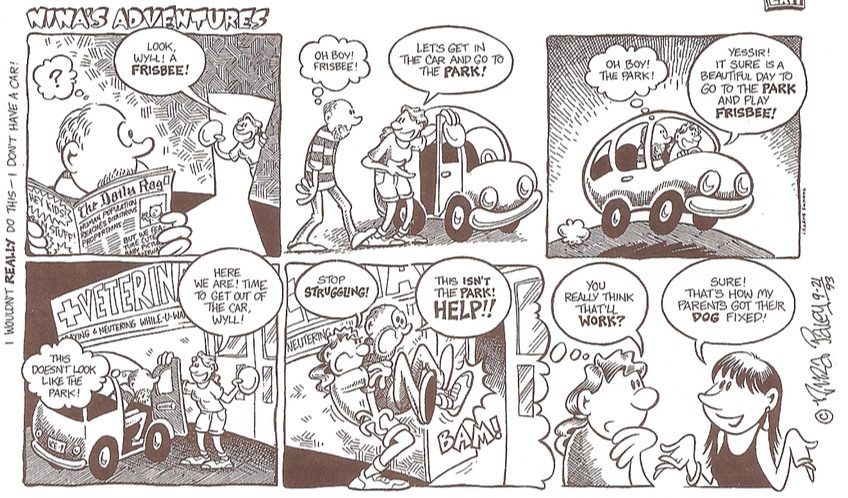
There’s a prison letter from folk singer slash Earth First! activist Peg Millett, under a headline that sounds like a good Onion joke.
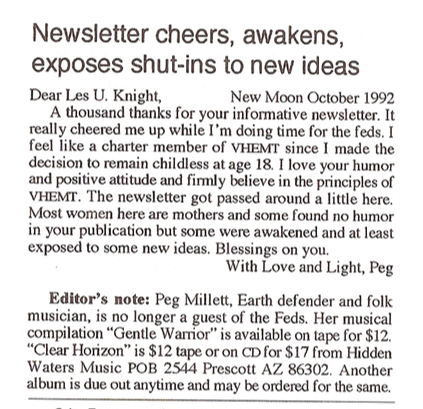
The issue also includes a Valentine’s Day contest to win a free vasectomy. Twenty-six men completed the following sentence on their entry form: “I want to tie the lover’s knot for my Valentine because…”
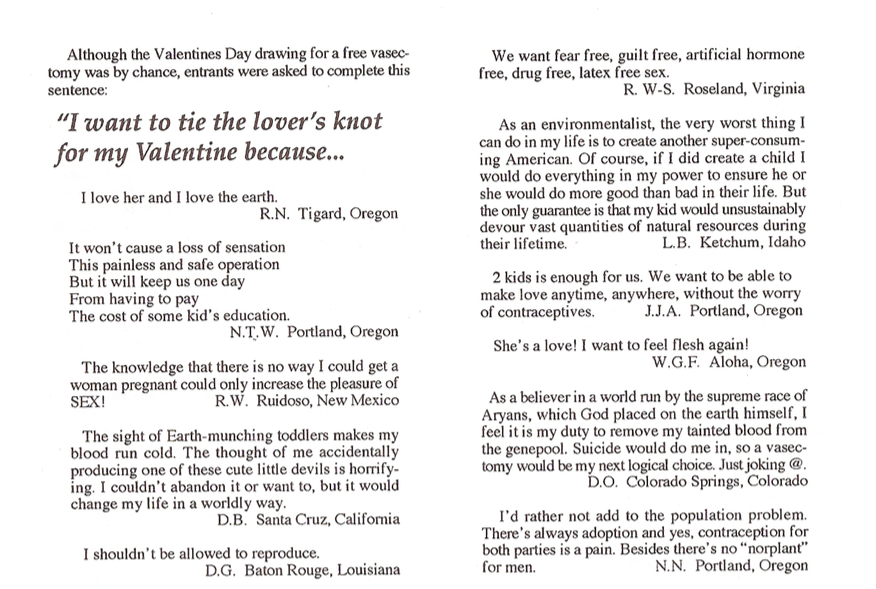
The final issue closes with a contraceptive pressure gauge.
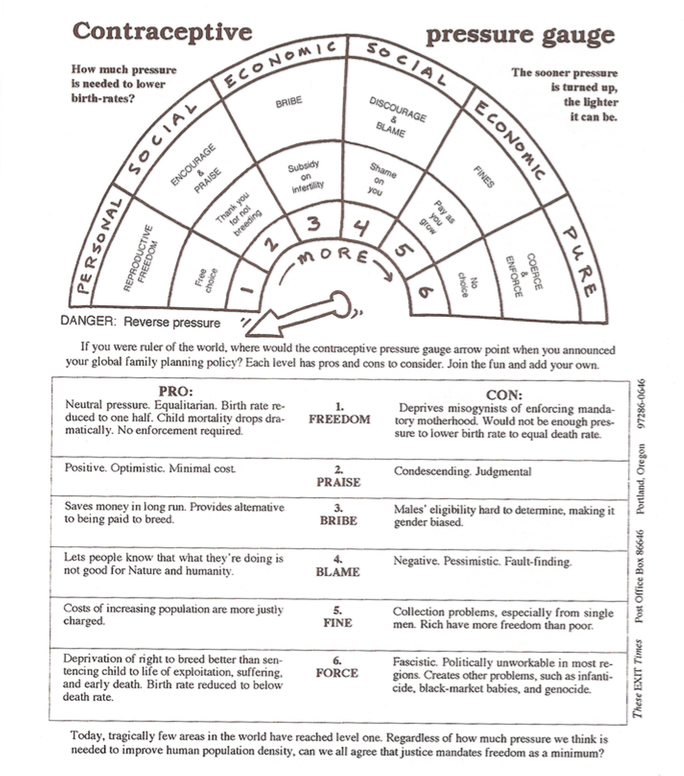
After the third issue, Knight killed These Exit Times. “It was time consuming and expensive,” he said, though he didn’t regret printing them. “The zines served their purpose well.” In their place, he created a website for the VHEMT. But, since a lot of humans still exist and are still having children (at least since I last checked), were the zines worth the trouble? “We’re spreading memes, not genes, so the more people who learn of VHEMT, whether they agree or not, it’s a success,” he said. “I’d like to think there are more than a few people who don’t exist thanks to our encouragement.”

Despite the fact that Knight seems like a genuinely nice, patient guy whose heart appears to be in the right place, there’s a relentless cynicism to his belief system: Humans are inherently destructive and evil; our world will inevitably be poisoned so long as we continue to exist; that any living being has more or less right to life than another, and we have the authority to determine this; and peacefully co-habiting with every other living being on our planet is impossible. The argument sounds like something from a mall goth, taking the most extreme, simplistic position to impress its friends.
If one wanted to dismiss the VHEMT’s arguments with a big condescending actually: The movement’s goals are rendered impossible by their own logic; if we are to assume that humans are so selfish/destructive that the earth is better off without us, it also holds that we’re too selfish/destructive to ever actually allow ourselves to die off. But let’s humor them.
Say, against all odds, that today, everyone on Earth agreed to allow humanity to die out, and the decision was reached peacefully and democratically. The last humans would be born roughly nine months from now. They’d probably become minor celebrities, and TV news shows would speculate about who the last person alive might be. At first, there wouldn’t really be any noticeable changes. But within twenty years, as about fifty-six million people die each year, the population would dip from seven billion to less than six billion; in forty years, less than five. Cities would slowly empty of people, as if they had sprung a leak. A quiet would gradually descend. Resources would be less scarce, for a time. It’d suddenly be easier to get a cab at rush hour in New York. At night, alarms would go off in the distance, from rusting cars belonging to no one.
In sixty years, some three-and-a-half billion people would remain. The youngest people in the world would be sixty years old. Infrastructure would have started to crumble. At some point, there wouldn’t be the critical mass of people required to maintain power plants and bridges and sewage treatment plants all at once. People would probably be too old to work to maintain them. Life would become more primitive. What would these remaining people be like? How much of our basic humanity is chained to the idea of survival and history, that once unmoored might drift completely away? What does it matter if you’re the last one left?
In eighty years, a little more than 2.3 billion people would remain, optimistically assuming a peaceful wind down. Maybe. Without infrastructure, and a supportive community of healthy people, and modern medicine, it’s hard to imagine people living beyond eighty. In any case, by this point, the population would very quickly crash.
Sometime within those few decades, the last person would collapse, unburied, leaving the Earth to rehabilitate. Before dying off, the last humans might build monuments, to commemorate how they made a noble choice to kill themselves to save the planet. In 7.2 million years, those monuments would fall apart, leaving no evidence that we ever existed. After that, based on the timeline of the far future: In eight hundred million years, all multi-cellular organisms would die out. In another seven billion years or so, the sun would expand in its red giant phase and obliterate the Earth. In 1010120 years, all the energy in the universe would extinguish, leaving an infinite void.
That’s the joke about the VHEMT: Regardless of when and how we leave, the ending’s always the same.
1. Many of these organizations were super racist — they were funded by John Tanton and U.S., Inc, and their environmentalism was just a guise to further a white supremacist agenda.
2. In 1993, Rev. Korda released a techno single, “Save the Planet, Kill Yourself.” Somehow, it never became a hit in clubs.
